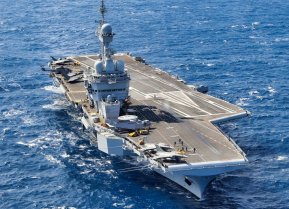Collins-Class: The Australian Submarine That 'Sunk' Due to Constant Breakdowns
When the Collins-class submarine was first built in 1990, the submarine marked a significant improvement in Australia’s military-industrial abilities.
Meet the Collins-Class: The Australians aren’t typically central to conversations about geopolitics, or about military planning. Australia is among the most out-of-the-way countries on Earth, situated closer to Antarctica than America or Europe. Yet, lately, the Australians are finding themselves in the conversation – as an important partner in an increasingly relevant corner of the glove.
China is currently engaged in one of human history’s most ambitious naval expansions. Adding cruisers, destroyers, and carriers, the world’s most populous country seems to have designs on dominating the Indo-Pacific. As China builds its military capabilities, the country has also engaged in a variety of territorial disputes – further suggesting an intent to exert influence beyond its borders.
Enter Australia. A first-world democracy, allied with America and with the commonwealth states, Australia has spent most of the Cold War, and the post-Cold War, on the sidelines. But with China pushing outward, Australia – remembering the Japanese landfall during World War II – is on guard, and carefully considering its military capabilities.
One Australian military system under consideration is the Collins-class submarine, a 1990s-era diesel sub that may be tasked with thwarting Chinese adventurism.
Collins-Class: A Major Step for Australian Industry
When the Collins-class was first built in 1990, the submarine marked a significant improvement in Australia’s military-industrial abilities. In fact, the Collins was the first submarine ever built in Australia. Prior to the Collins, the Royal Australian Navy relied upon the British-built Oberon-class submarine. But in 1983, the Australians solicited bids to craft a new submarine.
Several companies submitted a bid, including Directions Techniques Des Constructions Naval (France); Kockums (Sweden); Ingenieur Kontor Lubeck (Germany); Howaldtswerke-Deutsche Werft (Germany); Thyssen Nordseewerke (Germany); Cantieri Navali Ruiniti (Italy); United Shipbuilder Bureaux and Rotterdamsche Droogdok Maatschappij (both Dutch). After a controversial selection process, the Australians selected a bid from Swedish shipbuilder Kockums for the Type 471 design submarine.
Australian Shipbuilding Corporation was able to produce Australia’s first-ever domestic submarine. Six Collins subs were built; the program cost $5.1 billion total (in 1999 dollars) and $850 million per unit.
While the Collins marked a breakthrough for Australian industry, the submarine was not without its problems; a variety of incidents and technical setbacks occurred during the design phase – everything from accusations of foul play and bias during the selection process to capability deficiencies.
The finished product entered service with some ongoing technical problems – plus an inability to keep the subs sufficiently manned – making the Collins’s service life somewhat dramatic and headline-filled.
The Collins Design
Each Collins submarine was built using six sections – each of which featured several sub-sections. While the submarine was domestically built, plenty of international subcontractors were used; Construction work was subcontracted out to 426 companies from 12 different countries.
The finished product was 77.42 feet long with a 7.8-meter beam and a 7-meter draught. Submerged, the Collins displaces 3,407 tons. For propulsion, the Collins relies on three Garden Island-Hedemora HV V18b/15Ub (VB210) 18-cylinder diesel motors; three Jeumont-Schneider generators; and one Jeumont-Scheider DC motor capable of delivering 7,200 horsepower. The power system allows the Collins to reach speeds of 10 knots per hour at periscope depth and 20 knots when submerged. The Collins has a range of between 9,000 and 11,500 nautical miles and an overall endurance of 700 days – notably less than the nuclear-powered submarines that can operate indefinitely.
While the Collins’s performance specifications were mostly satisfactory, the submarine had several systems problems. The Collins created excessive noise, for example – not ideal when attempting to operate stealthily in enemy waters. The noise signature was especially pronounced when the Collins was operating at high speed. The culprit: the shape of the hull and propeller cavitation. Similarly, the Collins’s engine tended to break down.
Again, not ideal.
Even the submarine’s structural integrity was a problem; multiple defects were discovered in the welding to the Collins’s bow and escape tower section. The Collins’s propulsion system was unreliable, too; for a variety of reasons, the propulsion system often failed. The reasons include water leaks in the engines; bacterial contamination of the diesel fuel, and resultant rusting.
In short, the submarine was a mess. The Australian press seized upon the Collins’s shortcomings and before long, the submarine had become something of a political football.
The Collins on the World Stage
Understandably, the RAN (and the Americans) have some reservations about putting the Collins on the front lines of any confrontation with China. The Collins was only supposed to serve for about 30 years, with retirements tentatively set for around 2025.
Australia even began contemplating the next generation of submarines back in the mid-aughts. But the Collins is expected to remain in service for another maintenance cycle (seven years) or so.
Yet, the end is in sight. The announcement of the AUKUS trilateral security agreement between Australia, the United States, and the United Kingdom, ensures that the Australians will receive new nuclear-powered submarines, developed from American and British technology, to replace the beleaguered Collins-class.
About the Author
Harrison Kass is a prolific writer and defense expert with over 1,000 published pieces. An attorney, pilot, guitarist, and minor pro hockey player, Harrison joined the US Air Force as a Pilot Trainee but was medically discharged. Harrison holds a BA from Lake Forest College, a JD from the University of Oregon, and an MA from New York University. Harrison listens to Dokken.


